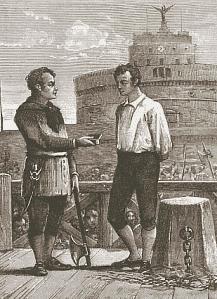Top Qs
Timeline
Chat
Perspective
Giovanni Battista Bugatti
Italian executioner (1779–1869) From Wikipedia, the free encyclopedia
Remove ads
Giovanni Battista Bugatti (6 March 1779 – 18 June 1869) was the official executioner for the Papal States from 1796 to 1865, during which he carried out 516 executions under six popes and the French government before being succeeded by his assistant Vincenzo Balducci. The list of people he executed ranged from thieves to assassins using methods such as beating, beheading, or hanging.
Remove ads
Personal life
Giovanni Battista Bugatti was born in Senigallia,[1] on 6 March 1779.[2] Bugatti was married, but had no children. Outside his functions as executioner, he worked as an umbrella maker.[3] He died in Senigallia[4] on 18 June 1869.[2] A book that claimed to be his memoir was published in 1891.[4][5]
Career
Summarize
Perspective

Bugatti became the official executioner for the Papal States at the age of 17[6] in 1796, and served until 1865.[7] His tenure was overseen by the popes Pius VI, Pius VII, Leo XII, Pius VIII, Gregory XVI, and Pius IX.[1] He also performed executions during the French occupation of the Papal States.[8] He offered snuff to those who were about to be executed.[5][9]
At the Via dei Cerchi[3] Bugatti executed 516 people with methods such as decapitation with an axe or guillotine, slicing their throats, or being drawn and quartered.[7] Bugatti's first execution was of Nicola Gentilucci, who was hanged and quartered in Foligno on 22 March 1796, after killing a priest and coachman and robbing two friars.[10] The last person he executed was Domenico Antonio Demartini, conducted on 17 August 1861, for murder.[3][11]
Between 28 February 1810, and 28 December 1813, Bugatti beheaded 56 people using the guillotine. Giuseppe Franconi, who was executed on 23 January 1826, was the last person Bugatti beat to death.[12] One man was hanged, quartered, and beheaded before having his body burned on 27 February 1800, for stealing two ciboria.[13] Domenico Capolei was executed on 2 May 1857, for killing the governor of Marino.[14] Antonio De Felici was executed on 11 July 1855, for attempting to assassinate Cardinal Secretary of State Giacomo Antonelli.[15]
Bugatti was not allowed to leave the Vatican except for official business; the payment for each execution was three cents of the Roman Lira. He was given a residence in Borgo and a pension after his retirement.[3] He was given the nickname Mastro Titta, a slurred version of maestro di Giustizia (master of justice).[3][16][17]
Vincenzo Balducci, Bugatti's assistant since 1850, succeeded him as executioner and served until 1870. Balducci executed twelve people.[1]
Remove ads
In popular culture
Charles Dickens wrote about Bugatti in Pictures from Italy after watching one of his executions in 1845. Depictions of Bugatti show him as tall, but he was short in real life.[3] A nursery rhyme about him goes:
Slice, slice, Mastro Titta
A loaf of bread and salami.
One for me, one for thee,
One for Mama, that makes three.[18]
See also
References
Works cited
Further reading
External links
Wikiwand - on
Seamless Wikipedia browsing. On steroids.
Remove ads

